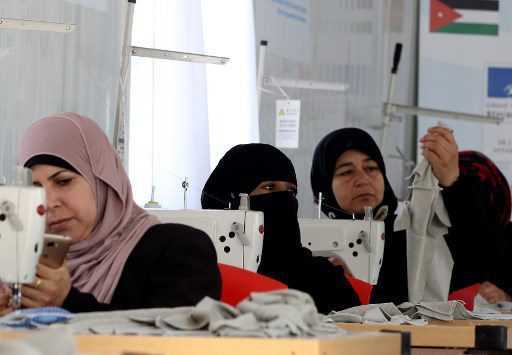COVID-19 pandemic disproportionately impacts Syrian refugees in Jordan
Syrian refugees have been hit hard by the economic repercussions of the COVID-19 pandemic in Jordan.
15 November 2020
Syrian refugees attend a sewing class at the Azraq camp for Syrian refugees in northern Jordan, 2/08/2018 (AFP)
AMMAN – “I have no hope for the future,” Marwa al-Nimr, a 31-year old Syrian refugee living in the Jordanian city of Zarqa, told Syria Direct.
Al-Nimr takes care of her two children, her aging mother and her father, the latter of whom is in Turkey but is unable to work due to his refugee status. She had previously worked as an employee of a refugee relief project and was on track to direct her own project with the backing of several NGOs. “It’s nice to be able to help people out, but I was excited to head my own project,” she said.
The project was set to launch in April, but then the COVID-19 pandemic reached Jordan and everything stalled. Jordan imposed a total lockdown on March 15, shuttering businesses and confining people to their homes. Since then, a partial curfew and business restrictions have been applied sporadically.
Citing funding concerns, the project al-Nimr was supposed to lead has now been delayed until December—though al-Nimr is skeptical of even this launch date. She has been unemployed since the lockdown was applied in March.
Al-Nimr’s economic situation is hardly unique in Jordan. Though the economic consequences of the global trade slowdown and the local COVID-19 shutdown have hit all of Jordan hard, it is the large population of refugees in Jordan that have found themselves most vulnerable to the downturn.
According to a rapid assessment by the International Labor Organization (ILO) in July, over a third of Syrian refugees in Jordan permanently lost their jobs due to the lockdown and 95 percent of Syrian refugee households reported a loss in household income.
The loss of livelihood has directly affected Syrian refugees, both inside and outside of camps.
According to a November World Food Program (WFP) food security update, 52 percent of adults in camps limit their food intake to ensure their children have enough to eat, as opposed to 3 percent in 2019. The WFP also reported that 88 percent of Syrian refugee households outside of camps are either food insecure or at risk of becoming food insecure.
Most of the 666,000 Syrian refugees registered with UNHCR in Jordan work in the informal sector and thus do not enjoy the social protections available to Jordanians. As of this summer, only 30 percent of Syrian refugees have valid work permits in Jordan, and only 24 percent are enrolled in social security, according to the ILO.
An October study by the Amman branch of the Centre for Lebanese Studies (CLS) shows that the COVID-19 lockdown has definitevely “worsened” Syrian refugees’ living conditions, regardless of whether they were living inside or outside of refugee camps, or whether they were “working in the private sector or working from home.”
The primary reasons for such adverse effects on Syrian refugees in Jordan are the lack of social protections afforded to them and their reliance on service delivery for their daily needs.
Since the majority of Syrians working in Jordan are daily wage earners, rather than being on a fixed monthly salary, the economic lockdown meant that they “were unable to make any money, buy food, or pay the rent for their houses,” according to the study.
Many of the economic sectors that were last to open up were in the service industry, where Syrians are concentrated, many of them not on contract due to policies meant to boost employment of Jordanians.
Even those not in the service sectors suffered from the macroeconomic effects of the lockdown.
Female Syrian refugees who were engaged with a USAID-funded project for home-based food businesses in the northern city of Irbid complained that demand for their products had slowed to a crawl since the lockdown in March, according to the CLS report.
The project mostly prepared homemade food and catered for events and social gatherings, such as weddings. However, due to restrictions on gatherings, orders have slowed dramatically, reducing the already meager income—50 Jordanian dinars ($70) a month—refugees typically made from the project.
The lack of demand and the subsequent impact on such home-based businesses affected primarily female refugees who have found employment in similar sectors, such as manufacturing. Male Syrian refugees typically work outside of the home in agriculture and construction, both of which are also highly sensitive to seasonal demand.
For those refugees in camps or confined to homes with few sources of income for themselves, the lockdown impacted their ability to receive services on a basic level. Due to the increased water consumption across Jordan since the lockdown, for example, less water has been provided to water-scarce areas where Syrian refugees live, creating concerns about water security.
One interviewee of the CLS study in al-Za’atari camp complained that water was pumped to their residential block for only one hour in the morning, and due to a lack of storage tanks, the area was suffering from a water shortage.
Above all else, however, the lockdown and the accompanying economic crisis has had serious psychological effects on refugees.
Al-Nimr told Syria Direct that her children’s psychological health has been affected by the lockdown, as they could not play outside or attend school in person. She is not only worried about her short term needs, but does not also know how she will be able to pay for her children’s university education in the future.
“Before, we thought the situation was bad in Jordan. You used to work just to eat. Now we just want to go back to how things used to be,” al-Nimr said.
This report is part of Syria Direct’s project promoting gender equality, supported by the Canadian Embassy to Jordan’s Canada Fund for Local Initiatives (CFLI).
This report reflects minor changes made on 15/11/2020.







